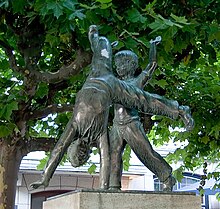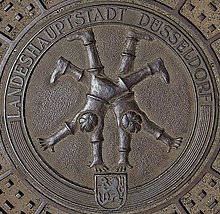Düsseldorf wheel racket



The Düsseldorfer Radschläger is a symbol of the city. The cartwheels of children is considered the oldest tradition of Dusseldorf . The symbol of the bike racket can be found on many souvenirs and in various Düsseldorf names.
Legends of origin and history
The origin of the custom cannot be tied to a single historical event , rather several stories entwine around the beginning of the Düsseldorf Radschläger.
Probably the best known variant is that of the Battle of Worringen . Count Adolf had defeated the Archbishop of Cologne in the battle of 1288 . As a result of the victory, Düsseldorf received city rights . The residents and especially the children ran out into the streets with joy and turned their wheels .
Another narrative is about a wedding procession in which a wheel was broken on the wedding carriage. In order to ward off the impending disaster, a boy jumped to the carriage, held the bike and thus became a living carriage wheel. Whether it was the wedding of Jan Wellem and Anna Maria Luisa de 'Medici or the wedding of Margravine Jacobe von Baden with Johann Wilhelm I is a matter of dispute.
Another variation takes this very wedding from 1585 of Margravine Jacobe von Baden to Johann Wilhelm. She is said to have been very unhappy about her marriage, but the story goes that the wheel racers, who showed their skills next to her carriage, made her smile.
At the end of the 19th century and the beginning of the 20th century, large exhibitions - the forerunners of today's trade fairs - attracted numerous travelers to the city. The children discovered that turning a wheel was a lucrative source of income. The bourgeoisie took winking this as parochial true symbolic action. If the toddlers initially shouted “för eene penning” (for a penny ), “I'll hit the wheel” , nowadays more is desired as a fee .
The cradle of the children who demonstrated their wheel racket skills lay between the former Theresienhospital , the former Douven'schem Haus and the Düsselschlösschen , where the Düssel flows into the Rhine.
When the evacuated Jan Wellem memorial was brought back to the city in 1945 after the war, not only torches and fanfares but also boys with bicycles accompanied the pageant.
Radschläger in the cityscape
The Radschläger can be found at several fountains in the city area. The best known is the Radschlägerbrunnen on Burgplatz with Hans Müller-Schlösser's inscription "Radschläger wolle mer blieve, wie jeck et de Minschen och drieve" (Radschläger we want to stay, how crazy people do it) , created in 1954 by Alfred Zschorsch and dated Heimatverein Düsseldorfer Jonges was donated. But also the manhole cover and the door knocker of the Lambertus Church , designed by the goldsmith Friedrich Becker - who also created the wheel racket in front of the Schadow Arcades - are decorated with it. In addition, a decorative vase designed by Willi Hoselmann around 1927 on the bank protection wall at Rheinpark Golzheim shows the wheel racer motif.

The customs have remained alive, particularly through the Alde Düsseldorfer Bürgergesellschaft von 1920 e. V. , which held the first wheel racket competition on October 17, 1937. Since 1971 it has been held annually in June together with the Stadtsparkasse on Königsallee , since 2006 on the Rheinwerft below the old town and has become an integral part of the Düsseldorf event program. Over 500 boys and since 1971 also girls take part regularly.
The sculpture popularly known as Radschläger , the 36-meter-high and 30-tonne “pylon” made of V2A steel by Max Kratz , stands in front of Düsseldorf Airport today . The two diverging tips of the sculpture stylize the legs of the Düsseldorf wheel racer.
In 2001 the project Radschläger-Kunst was started, in which over 100 Radschläger sculptures were created by artists and hobby artists. The sculptures , in which the door knocker on the Lambertus Church served as the starting model, are two meters high and wide and 30 centimeters deep. They were distributed throughout the city and only some of them were bought by private individuals or companies at the end of the year .
Over and over again there were disputes over the copyrights to the form of the Radschläger created by Professor Friedrich Becker, which were regularly ended by warnings to the detriment of the imitators. Another legal dispute arose through an heir, which went as far as the Düsseldorf Regional Court. Her lawsuit was rejected. In July 2020, the court found that the alleged copy created by the defendant was sufficiently different from the Radschläger of the Becker factory.
Web links
Individual evidence
- ↑ Kulturamt Düsseldorf Title: Messezeichen, Object number: KA.SB413
- ↑ Trial before the Düsseldorf Regional Court: Who does the Radschläger belong to? Westdeutsche Zeitung , February 18, 2020. Accessed July 28, 2020.
- ↑ Peter Kurz: Judgment in the copyright lawsuit - both wheel rackets are allowed to turn . Westdeutsche Zeitung , July 15, 2020. Accessed July 28, 2020.

